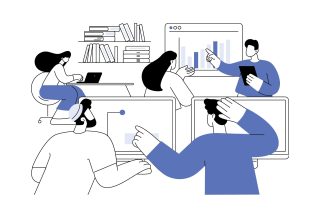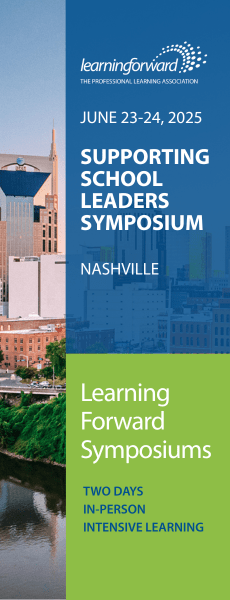FOCUS
How professional learning can help close digital divides
By Zac Chase
Categories: Reaching all students, TechnologyApril 2024
The nature of the digital divide in schools is changing. Once understood to be about gaps in access to computer and internet technology across demographic and geographic groups, the gap is now more complex. Schools still experience inequity in technology, but it is as much about educators’ capacity and opportunity to apply technology in meaningful ways as it is about software licenses or internet speed.
To close those gaps and realize the potential of technology for all students, we need to reimagine professional learning about and with technology. That is one of the main recommendations of the new National Educational Technology Plan: A Call to Action for Closing the Digital Access, Design, and Use Divides, which was published by the U.S. Department of Education in January 2024.
First published in 1996 in fulfillment of the 1994 Improving America’s Schools Act, the National Educational Technology Plan has been updated every four to six years since, with the previous full revision taking place in 2016.
The 2024 version homes in on three distinct but related divides limiting educators’ and students’ abilities to benefit fully from technology. All three are tied to the instructional core (City et al., 2009), which describes how the relationship between the teacher, student, and content come to define instructional practice and tasks. The three divides are:
- Digital use divide: Inequitable implementation of meaningful instructional tasks supported by technology (that is, using technology to analyze, build, produce, and create, rather than using technology for passive assignment completion).
- Digital design divide: Inequitable access to time and support for professional learning for all educators to build their capacity to design learning experiences for all students using educational technology.
- Digital access divide: Inequitable access to connectivity, devices, and digital content, as well as instruction in digital health, safety, and citizenship skills.
The digital design divide, which is included for the first time in the 2024 version, addresses gaps “between and within those systems that provide every educator the time and support they need to build their capacity with digital tools and those that do not” (U.S. Department of Education Office of Educational Technology, 2024, p. 34). Calling out this divide makes explicit the need for high-quality professional learning on educational technology, and the plan includes recommendations and examples to realize that goal.
 The digital divide in schools isn't just about access, it's about how we use tech for meaningful learning. The new National Educational Technology Plan highlights the need to reimagine professional learning for educators.… Share on X
The digital divide in schools isn't just about access, it's about how we use tech for meaningful learning. The new National Educational Technology Plan highlights the need to reimagine professional learning for educators.… Share on X
Re-envision professional learning
The call for more and better professional learning is not new (Cuban, 2018; Watters, 2023; Reich, 2020; Papert & Solomon, 1971). Even the first iteration of the National Educational Technology Plan from 1996 pointed out the need to attend to professional learning, stating, “All teachers in the nation will have the training and support they need to help students learn using computers and the information superhighway.” It continues, “Upgrading teacher training is key to integrating technology into the classroom and to increasing student learning” (U.S. Department of Education, 1996). But that vision has not been fully realized, and professional learning has not kept pace with the rapid evolution of learning technology.
The 2024 version recognizes that we need to re-envision and recommit to professional learning. Reimagining includes looking to the future and new approaches to professional learning that put everything on the table in designing the systems all educators need to provide all students with the learning experiences they deserve.
At the same time, it means helping all schools align their efforts with the Every Student Succeeds Act’s definition of professional development as “… sustained (not stand-alone, 1-day, or short term workshops), intensive, collaborative, job-embedded, data-driven, and classroom-focused” and as encompassing “teachers, principals, other school leaders, specialized instructional support personnel, paraprofessionals, and, as applicable, early childhood educators” (Every Student Succeeds Act, 2015).
This future-facing thinking is in the work of Brigantine Public Schools in New Jersey and the process the district undertook to build a schedule providing teachers an additional planning period for common planning time, articulation meetings, and sharing or teaching new approaches to technology use for staff and students (U.S. Department of Education Office of Educational Technology, n.d.a).
It’s the work of the Illinois State Board of Education’s Learning Technology Center Instructional Technology Coach Program, which uses a cost-sharing model, allowing multiple districts in a similar geographic area of the state to share the costs of an instructional technology coach for a predetermined number of days throughout the school year (U.S. Department of Education Office of Educational Technology, n.d.b).
And it’s in the work of Denver Public Schools in Colorado, where the district has heeded the research challenging the effectiveness of one-off professional learning and now requires teachers attending district professional learning workshops to commit to participating in a full professional coaching cycle to shift practice (U.S. Department of Education Office of Educational Technology, n.d.c). (Editor’s note: See this article for their story.)
 Integrating tech effectively takes future-facing thinking. New Jersey's @brigschools provides with teachers an additional common planning period to design and refine tech use for staff and students. #Teaching #Learning Share on X
Integrating tech effectively takes future-facing thinking. New Jersey's @brigschools provides with teachers an additional common planning period to design and refine tech use for staff and students. #Teaching #Learning Share on X
Four recommendations for closing the digital design divide
With nearly 14,000 school districts in the United States, it is impossible (and would be unhelpful) to prescribe programs and solutions as though one size fits all. Meeting local needs means being sensitive to context and culture within districts and schools. With this contextual sensitivity in mind, the National Educational Technology Plan recommends four strategies for closing the digital design divide that education systems at multiple levels can apply and adapt to fit their needs.
Develop a “portrait of an educator” outlining the cognitive, personal, and interpersonal competencies educators should have to design learning experiences that help students develop the skills and attributes outlined in the portrait of a graduate.
In taking the time to draft a profile of an educator outlining the skills, habits, and expected capacities of educators, districts and schools begin to signal what is important within their systems while also giving language to the culture of learning they are working to build and creating goals for professional learning. A portrait of an educator that includes high-quality technology integration can help systems develop and communicate a mindset of technology as ubiquitous, necessary, and seamless, rather than an add-on or nice to have.
This would be a benefit in several ways, including hiring. Currently, a common question in educator interviews goes something like this: “Can you tell us about a time you successfully used technology to support learning?” But candidates’ answers to such questions are inherently outdated because technology evolves so quickly. Using the portrait of an educator as a North Star, leaders can instead ask questions of potential hires that reflect their capacity to use and adapt with technology, such as: “Will you tell us about the last time something went wrong with technology in your classroom and how you dealt with it?” or “Can you tell us how you select technology tools for your classroom that meet all students’ needs and create multiple means for students to show their learning?”
Beyond hiring, educator portraits can also help districts decide what to stop doing. By measuring current programs and practices against their goals for all educators, systems like Brigantine and Denver were able to identify what they could subtract to add more professional learning time and the resources they needed to help all teachers increase their capacity for better learning design.
Provide educators and administrators with professional learning that supports the development of digital literacy skills so that they can model these skills for students and the broader school community.
Simply put, it is no longer acceptable or responsible for professional educators to claim, “I’m not a tech person,” when technology has become integral to communicating with parents and caregivers, crucial to meeting the needs of students with disabilities, interwoven in our collaborative tools, and inseparable from the future success of students (Bughin et al., 2018).
Understanding resistant educators’ concerns can help those charged with organizing professional learning understand the needs of professional learners. Questions to consider include:
- How do we ensure educators of all backgrounds and experiences — including those who are reluctant to use technology — are co-designers of professional learning?
- What elements of professional learning regarding technology have been harmful or ineffective in the past?
- How do we set an expectation of progress and not perfection to keep the perfect from becoming the enemy of the good?
- How do we hold what is most valuable to learning as core to professional learning and avoid centering technology for its own sake?
Finding the answers to these questions represents an opportunity to invite those same people affected by them into the process of building better professional learning.
Develop processes for evaluating the potential effectiveness of digital tools before purchase, including the use of research and evidence.
Professional learning concerning technology tools can begin even before those tools have been purchased by setting clear standards of quality, effectiveness, and functionality for devices and digital resources. When educators know such standards exist and are invited into developing those standards as well as the evaluation process, cultures of trust can grow.
In systems without such collaborative evaluation approaches, tools can seemingly come and go at random, and educators may have no clear understanding of whether they are effective or pedagogically aligned. This revolving door of products and tools can make educators feel cynical about the value of professional learning about technology because they believe the tools will keep changing just as they have mastered the previous ones.
Design and sustain systems that support ongoing learning for new and veteran teachers and administrators, providing them with the time and space needed to design learning opportunities aligned with the Universal Design for Learning framework.
The principles and framework of Universal Design for Learning (CAST, 2018) are key to the 2024 National Educational Technology Plan, encouraging educators to design technology-rich learning environments where all students can succeed. At its core, Universal Design for Learning repositions the learning environment and experience as either enabling or disabling by design, rather than positioning the learner as inherently capable or incapable. Universal Design for Learning encourages educators to incorporate design features that accommodate all students’ needs and recognizes that an accommodation designed for certain needs can benefit everyone.
The Universal Design for Learning framework rests on three principles:
- Provide multiple means of engagement.
- Provide multiple means of representation.
- Provide multiple means of action and expression.
While application of the Universal Design for Learning framework as outlined by CAST, the organization that created it, can be achieved without the use of technology, educators have increased access to technology tools for putting these three principles into action. But doing so takes dedicated time and effort for educators’ learning.
The plan includes a hypothetical example of Universal Design for Learning in action, which illustrates the level of skill a teacher needs to apply the principles to a unit about understanding ecological concepts associated with diversity and sustainability.
The teacher, Mrs. Ramirez, starts by identifying the unit’s goal and considering the barriers that might emerge in the learning process. She then considers how multiple means of representation, engagement, action, and expression might overcome these barriers.
She leverages technology to ensure all her students can access and understand the content, some through an immersive 360-degree virtual tour of rainforests, others, including a blind student, listening to narrated podcasts about aquatic ecosystems, and some, including two students with learning differences, using interactive simulations that allow them to manipulate ecosystem variables.
Mrs. Ramirez goes on to use other tools for collaborative group projects, data collection and organization, and presentations and embraces diverse assessment methods so all students can demonstrate their understanding. She supports all students in learning the content while helping them develop digital literacy and citizenship skills.
The kind of design Mrs. Ramirez implemented does not happen by chance, and it doesn’t happen overnight. It requires a thoughtful, comprehensive reimagining of instructional design, which considers all available learning tools and allows for all students to move toward the same learning goals along different trajectories and with different tools.
That takes in-depth, sustained professional learning, perhaps with coaching and professional learning communities that prompt teachers to self-assess, reflect, and continue to try new things. Principals and other leaders also need professional learning so they can support and evaluate the classroom appropriately.
The 2024 National Educational Technology Plan provides examples of districts and schools across the U.S. that have undertaken this reimagining of teaching and learning and the professional learning they have used to support it. The plan continues to refine our understanding of the meaning of equity in educational technology and how technology can transform learning for all students.
Download the PDF here.
Disclaimer from the U.S. Department of Education
This article contains resources that are provided for the reader’s convenience. The inclusion of these materials is not intended to reflect its importance, nor is it intended to endorse any views expressed or products or services offered. These materials may contain the views and recommendations of various subject matter experts as well as hypertext links, contact addresses, and websites to information created and maintained by other public and private organizations. The opinions expressed in any of these materials do not necessarily reflect the positions or policies of the U.S. Department of Education. The U.S. Department of Education does not control or guarantee the accuracy, relevance, timeliness, or completeness of any outside information included in these materials.
References
Bughin, J., Hazan, E., Lund, S., Dahlström, P., Wiesinger, A., & Subramaniam, A. (2018). Skill shift: Automation and the future of the workforce. McKinsey & Company.
CAST. (2018). The UDL guidelines. udlguidelines.cast.org/
City, E.A., Elmore, R., Fiarman, S., & Teitel, L. (2009). Instructional rounds in education. Harvard Educational Publishing Group.
Cuban, L. (2018). The flight of a butterfly or the path of a bullet? Using technology to transform teaching and learning. Harvard Education Press.
Every Student Succeeds Act, 20 U.S.C. § 6301 (2015). www.congress.gov/bill/114th-congress/senate-bill/1177
Papert, S. & Solomon, C. (1971). Twenty things to do with a computer. Artificial Intelligence Memo Number 248. Massachusetts Institute of Technology.
Reich, J. (2020). Failure to disrupt: Why technology alone can’t transform education. Harvard University Press.
U.S. Department of Education. (1996). Getting America’s students ready for the 21st century: Meeting the technology literacy challenge. Author. files.eric.ed.gov/fulltext/ED398899.pdf
U.S. Department of Education Office of Educational Technology. (2024). A call to action for closing the digital access, design, and use divides: 2024. Author.
U.S. Department of Education Office of Educational Technology. (n.d.a). Reconsidering educator learning time to improve student learning time. tech.ed.gov/stories/reconsidering-educator-learning-time-to-improve-student-learning-time/
U.S. Department of Education Office of Educational Technology. (n.d.b). State program facilitates the sharing of instructional technology coaches among districts. tech.ed.gov/stories/state-program-facilitates-the-sharing-of-instructional-technology-coaches-among-districts/
U.S. Department of Education Office of Educational Technology. (n.d.c). Designing wrap-around teacher support as a new normal. tech.ed.gov/stories/designing-wrap-around-teacher-support-as-a-new-normal/
Watters, A. (2023). Teaching machines: The history of personalized learning. MIT Press.
Zac Chase (Zachary.Chase@ed.gov) is Digital Equity Impact Fellow at the U.S. Department of Education Office of Educational Technology.
Categories: Reaching all students, Technology
Recent Issues
LEARNING DESIGNS
February 2025
How we learn influences what we learn. This issue shares essential...
BUILDING BRIDGES
December 2024
Students benefit when educators bridge the continuum of professional...
CURRICULUM-BASED PROFESSIONAL LEARNING
October 2024
High-quality curriculum requires skilled educators to put it into...
LEARNING TO PIVOT
August 2024
Sometimes new information and situations call for major change. This issue...












